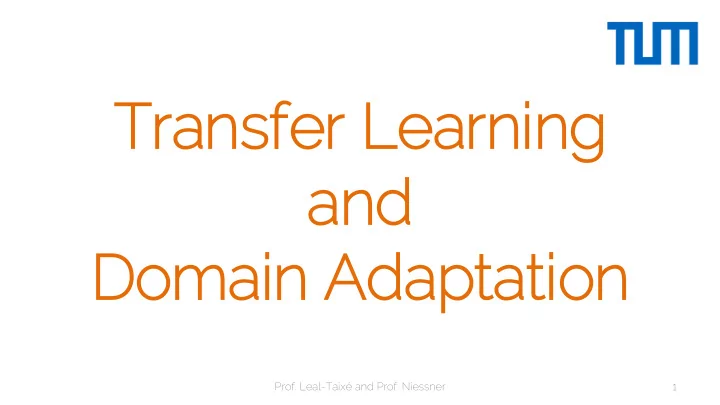

Transfer Learnin ing and Domain in Adaptatio ion Prof. Leal-Taixé and Prof. Niessner 1
Big iggest Cri riticis ism of f Computer Vis ision Works on constructed datasets, but not in the real world… … and that’s also true for deep learning Prof. Leal-Taixé and Prof. Niessner 2
E.g .g., ., Mult lti-Dataset Eff fforts Robust Vision Challenge: CVPR’18 [Geiger/Niessner/ Pollefeys/Rother et al.] Prof. Leal-Taixé and Prof. Niessner 3
Tra ransfer r Learn rnin ing & Domain in Adaptatio ion Task • – Image Classification – Image Segmentation – Object Instance Segmentation – … Domain • – Real data • Real != real: webcam model 1 vs webcam model 2; day vs night – Synthetic data • E.g., rasterization vs – … Prof. Leal-Taixé and Prof. Niessner 4
Tra ransfer r Learn rnin ing & Domain in Adaptatio ion Prof. Leal-Taixé and Prof. Niessner 5 Source: wikipedia
Tra ransfer Learning Same domain, different task • Pre-trained Image Net (visual domain of real images) – Train on image classification • Fine-tune on new task – E.g., semantic image segmentation – > keep ‘backbone the same, fine - tune ‘head’ layers – > assumption: visual features generalize within domain Prof. Leal-Taixé and Prof. Niessner 6
Tra ransfer Learning Same task, different domain • Pre-trained Image Net (visual domain of real images) – Train on image classification • Fine-tune on new task – Now need to train *entire* network, cuz input features will be different – Training only a few layers at the end is less likely to fundamentally solve it Prof. Leal-Taixé and Prof. Niessner 7
Fin ine Tunin ing • How much labeled data in the target domain? – Zero-shot learning – One-shot learning – Few-shot learning • Just ‘throwing in as much data as we can’ seems somewhat unsatisfactory… Prof. Leal-Taixé and Prof. Niessner 8
Domain in Adaption Prof. Leal-Taixé and Prof. Niessner 9
Applic icatio ions to diff ifferent types of f domain in shift ift From dataset to dataset From RGB to depth From simulated to real control From CAD models to real images Slide Credit: Kate Saenko
Advers rsari rial domain adaptatio ion Classifier fc fc classification conv1 conv5 loss 6 7 backpack chair bike Source Data + Labels Unlabeled Target Data fc fc conv1 conv5 6 7 ? Slide Credit: Kate Saenko
Advers rsari rial domain adaptatio ion Classifier classification Encoder loss backpack chair bike Source Data + Labels can be shared Unlabeled Target Data Encoder ? Slide Credit: Kate Saenko
Advers rsari rial domain adaptatio ion Classifier classification Encoder loss backpack chair bike Source Data + Labels can be shared Unlabeled Target Data Discriminator Adversarial loss Encoder ? Slide Credit: Kate Saenko
Advers rsari rial domain adaptatio ion Classifier classification Encoder loss backpack chair bike Source Data + Labels can be shared Unlabeled Target Data Discriminator Adversarial loss Encoder ? Slide Credit: Kate Saenko
Results on City ityscapes to SF adaptatio ion Before domain After domain confusion confusion FCNs in the Wild: Pixel-level Adversarial and Constraint-based Adaptation, Judy Hoffman, Dequan Wang, Fisher Yu, Trevor Darrell, Arxiv 2016
Cycle-Consis istent Adversaria ial Domain in Adaptatio ion CyCADA [Hoffman et al. 2018] Prof. Leal-Taixé and Prof. Niessner 16
Cycle-Consis istent Adversaria ial Domain in Adaptatio ion CyCADA [Hoffman et al. 2018] Prof. Leal-Taixé and Prof. Niessner 17
Exam • Slides provide additional references (use them) • Look up the important papers that we discussed • Understanding of – high-level concepts – underlying math – architecture design Prof. Leal-Taixé and Prof. Niessner 18
Admin inistrative • Deadline for final projects – Wed d Fe Feb 6 th th , 11 11:59 :59pm – Submission via moodle – Submission must contain • Code (results must be replicable) • 2-3 pages of final report (at most 1 page of text, rest results; i.e., images and tables) • Use CVPR templates: http://cvpr2019.thecvf.com/submission/main_conference/ author_guidelines Prof. Leal-Taixé and Prof. Niessner 19
Admin inistrative • Poster presentation – Fri Friday Fe Feb 8 th th , 1p 1pm-3pm 3pm – Location: • Magistrale (preliminary – will update if it changes) • In the area next to the back entrance (parking lot direction) – Poster stands will be provided – You need to print posters yourself (poster@in.tum.de) – Hang posters 15 mins before presentation session starts Prof. Leal-Taixé and Prof. Niessner 20
Guest Speakers • Oriol Vinyals: – https://ai.google/research/people/OriolVinyals – Time: Ja January 31 31 st st , 6pm – 8pm – Location: HS-1 (CS building – the big one) Prof. Leal-Taixé and Prof. Niessner 21
Next Lectures This was the last lecture Prof. Leal-Taixé and Prof. Niessner 22
Recommend
More recommend